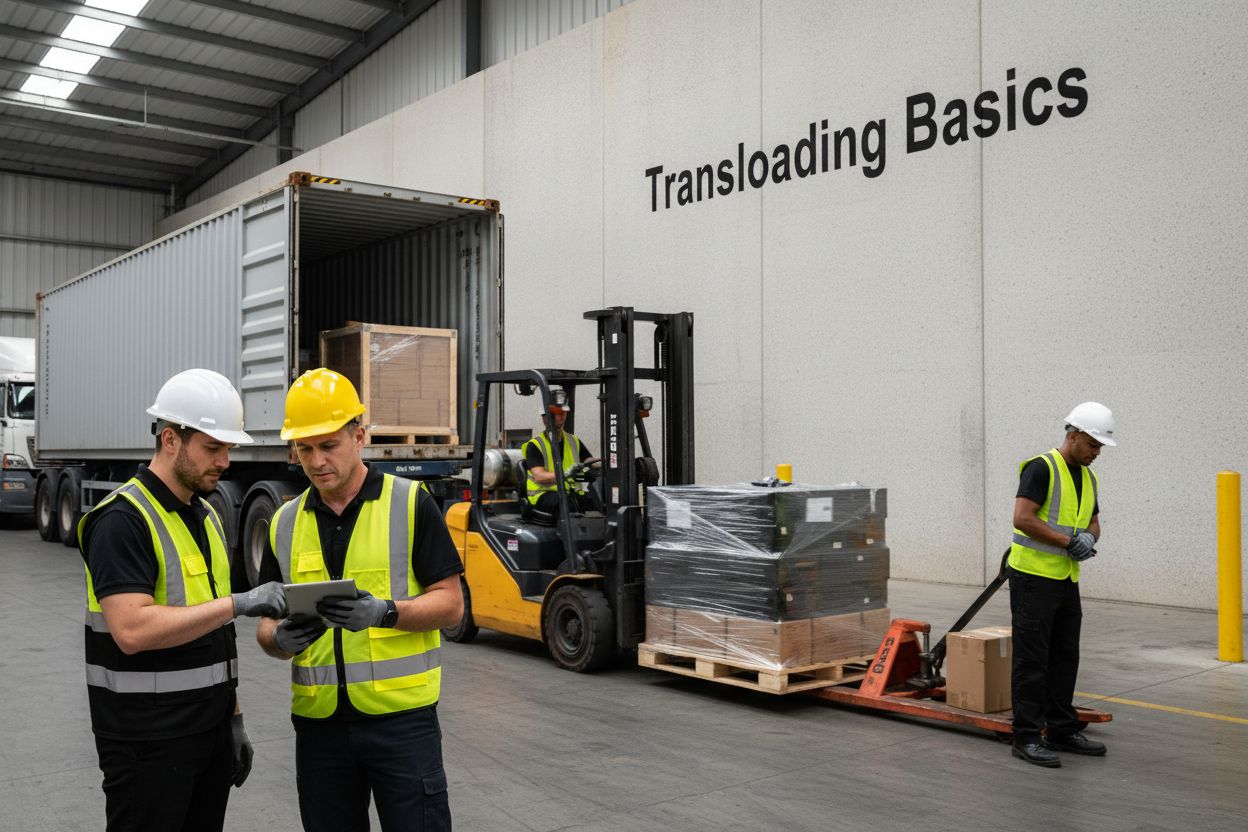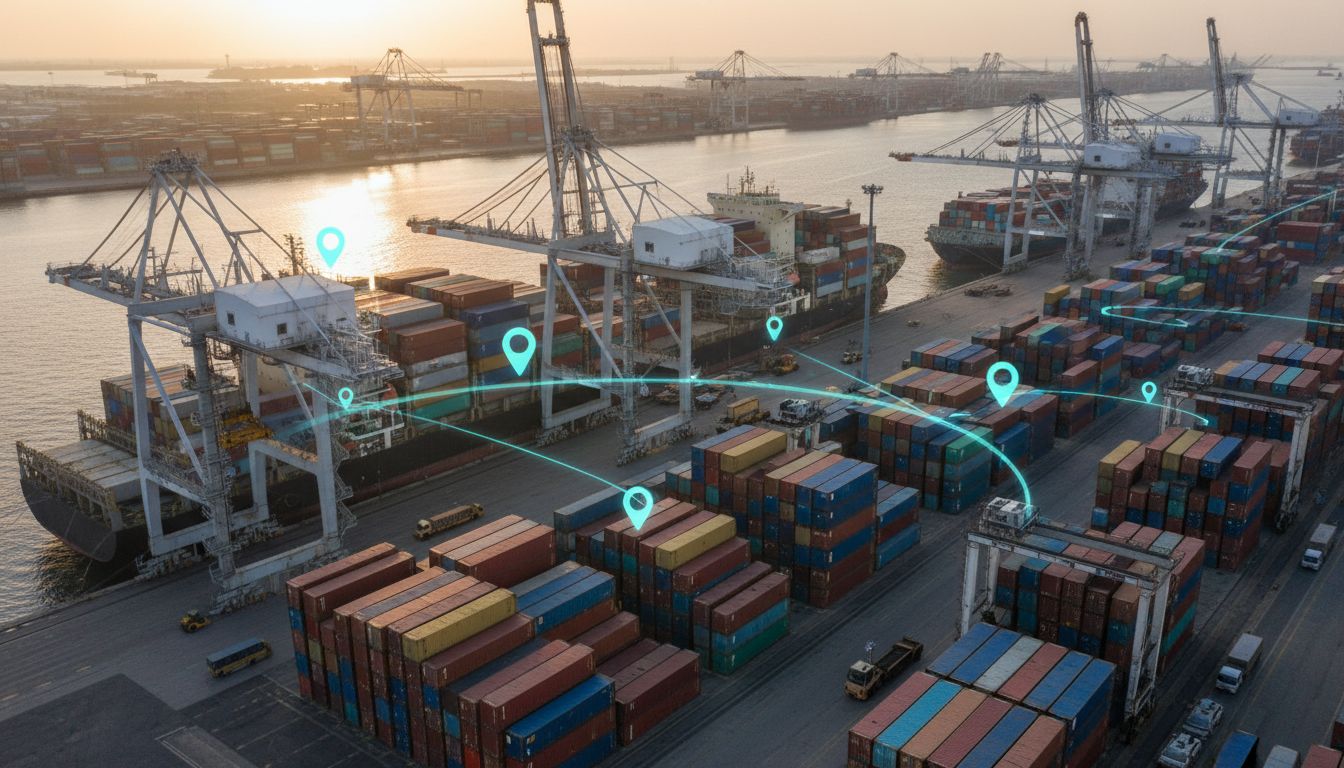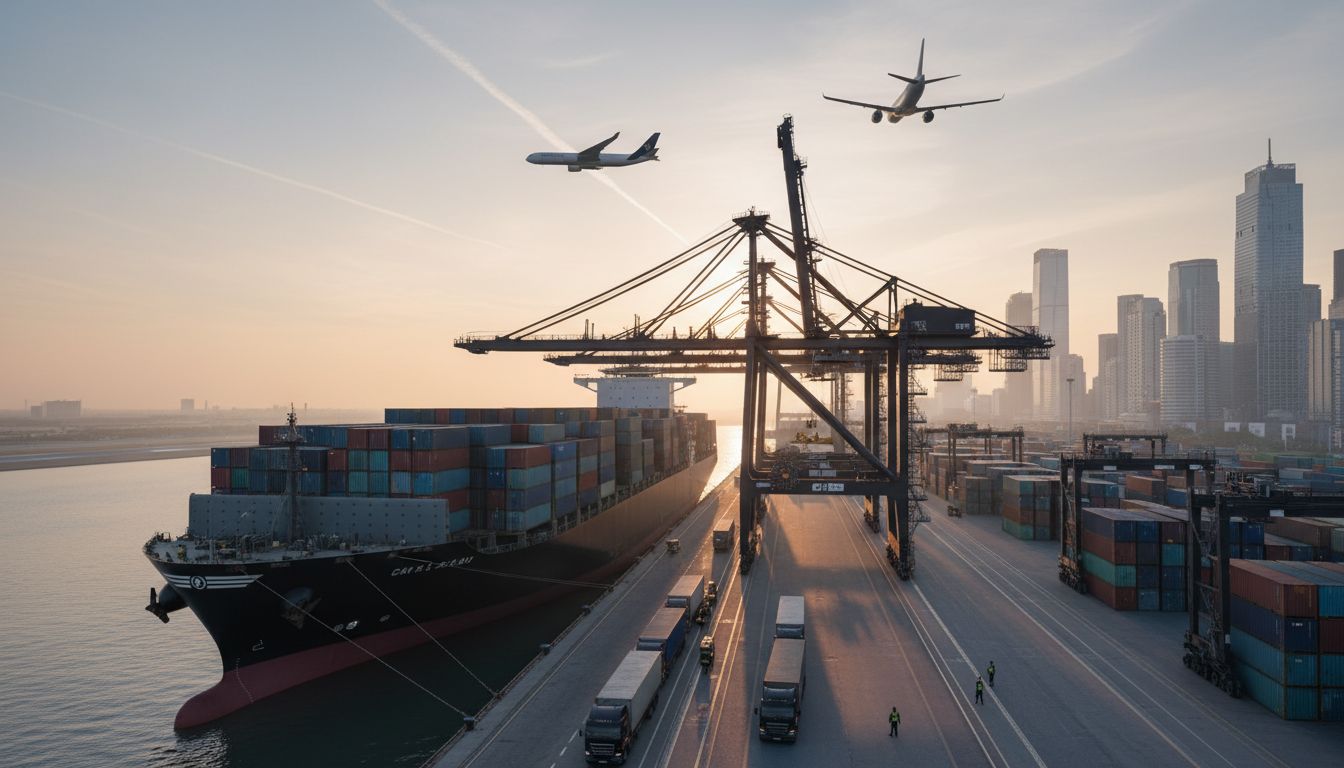Shipping delays and rising costs are becoming the norm for global businesses. Yet transloading can cut transportation expenses by up to 30 percent while making your supply chain more flexible. Oddly enough, the real surprise is that transloading is not just about moving freight—it can protect your business from costly disruptions you never even saw coming.
Table of Contents
- Defining Transloading: The Basics Of Freight Transfer
- The Importance Of Transloading In Supply Chains
- How Transloading Works: The Process Explained
- Key Concepts And Terminology In Transloading
- Real-World Applications And Benefits Of Transloading
Quick Summary
| Takeaway | Explanation |
|---|---|
| Transloading optimizes shipping routes. | It allows businesses to switch between transport modes for better efficiency and cost savings. |
| Reduces transportation costs significantly. | Companies can leverage various modes to minimize expenses and streamline their shipping processes. |
| Enhances supply chain flexibility. | Quick mode switching helps businesses adapt to disruptions and maintain continuous cargo movement. |
| Requires specialized transloading facilities. | Efficient cargo transfer depends on infrastructure like cranes and proper storage at strategic locations. |
| Supports diverse industry applications. | Various sectors, from manufacturing to agriculture, benefit from transloading to manage logistics effectively. |
Defining Transloading: The Basics of Freight Transfer
Transloading represents a strategic logistics method where cargo is transferred between different transportation modes during its journey from origin to final destination. Unlike direct shipping, this approach allows businesses to optimize transportation efficiency, reduce costs, and navigate complex shipping routes more effectively.
What is Transloading in Modern Logistics?
At its core, transloading involves moving freight from one type of transportation carrier to another. This could mean transferring goods from an ocean container to a truck, from a train to a warehouse storage system, or between various transportation vehicles to reach the ultimate delivery point. Learn more about key freight terms that help understand these complex logistics processes.
Key characteristics of transloading include:
- Flexibility in transportation routing
- Ability to leverage different transportation modes
- Potential for significant cost savings
- Enhanced supply chain adaptability
How Transloading Works in Practice
The transloading process typically occurs at specialized facilities designed to handle cargo transfers efficiently. These facilities are strategically located near transportation hubs like ports, rail yards, or major highway intersections.
Trained logistics professionals carefully unload cargo from one transportation mode and reload it onto another, ensuring minimal handling damage and maximum efficiency.
For instance, an international shipment might arrive via ocean freight in a shipping container. At a transloading facility, workers will unload that container, potentially repackage or consolidate goods, and then transfer those items to a truck or train for final domestic distribution. This approach allows businesses to select the most cost-effective and appropriate transportation methods for different segments of their shipping journey.
The Importance of Transloading in Supply Chains
Transloading plays a critical role in modern global supply chain management, serving as a strategic solution that enables businesses to optimize their shipping operations and reduce overall transportation expenses. By providing unprecedented flexibility in cargo movement, transloading has become an essential logistics strategy for companies seeking efficient and cost-effective shipping methods.
Strategic Cost Optimization
One of the primary advantages of transloading is its ability to significantly reduce transportation costs. Companies can leverage different transportation modes to minimize expenses by selecting the most economical routes and carriers for each segment of a shipment’s journey. Explore more about logistic providers to understand how these strategies are implemented.
Key financial benefits of transloading include:
- Reduced per-mile transportation expenses
- Elimination of dedicated full truckload shipping requirements
- Enhanced ability to consolidate smaller shipments
- Lower warehousing and inventory carrying costs
Supply Chain Resilience and Adaptability
In an increasingly complex global trade environment, transloading provides businesses with critical supply chain resilience. The ability to quickly switch between transportation modes allows companies to respond rapidly to disruptions, such as port congestion, transportation network challenges, or unexpected logistical constraints.
This approach enables businesses to maintain continuous cargo movement by creating alternative routing options. When one transportation mode experiences delays or restrictions, transloading facilities can quickly redirect shipments through different carriers or routes, ensuring minimal supply chain interruption and maintaining consistent product availability.
How Transloading Works: The Process Explained
Transloading is a sophisticated logistics process that requires precise coordination, specialized infrastructure, and strategic planning to successfully transfer cargo between different transportation modes. Understanding logistics infrastructure is crucial for comprehending the intricacies of this complex transportation method.
Infrastructure and Facility Requirements
Successful transloading depends on specialized facilities strategically positioned near critical transportation networks. These transloading facilities are equipped with advanced handling equipment like cranes, forklifts, conveyor systems, and storage capabilities that enable efficient cargo transfer.
Key infrastructure components include:
- Spacious loading and unloading zones
- Advanced material handling equipment
- Climate-controlled storage spaces
- Robust tracking and inventory management systems
Cargo Transfer and Handling Protocols
The transloading process involves multiple precise steps designed to ensure cargo integrity and minimize potential damage during transfer. Trained logistics professionals carefully plan and execute each movement, considering factors like cargo type, packaging requirements, weight distribution, and transportation mode specifications.
A typical transloading sequence involves unloading cargo from the original transportation mode, potentially repackaging or consolidating shipments, and then strategically reloading onto the next transportation vehicle. This approach allows for maximum transportation efficiency and enables businesses to optimize their shipping routes based on cost, speed, and logistical constraints.
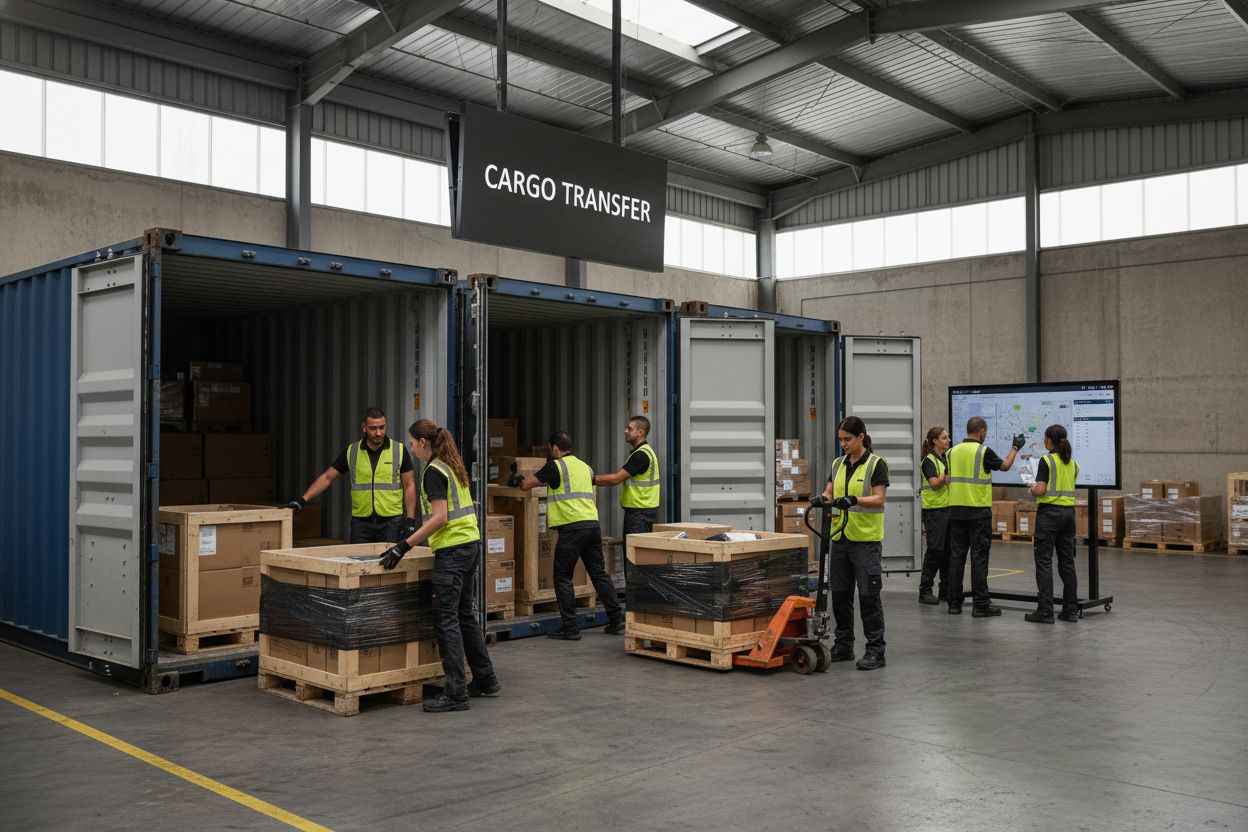
Transloading operations are often implemented at critical transportation junctions such as ports, rail terminals, and warehouses, where shipments can be seamlessly broken down and reassembled to meet the specific requirements of subsequent transportation modes.
Key Concepts and Terminology in Transloading
Transloading involves a complex network of specialized terminology and concepts that professionals use to communicate effectively and manage sophisticated logistics operations. Understanding these key terms is essential for businesses seeking to optimize their shipping strategies and navigate the intricate world of freight transportation.
The table below summarizes essential transloading terms and their meanings, helping readers quickly understand key vocabulary in logistics and freight movement.
| Term | Definition |
|---|---|
| Transloading | The process of transferring cargo between different transportation modes during a journey. |
| Intermodal Transportation | Moving cargo using multiple transport modes without direct handling of the freight. |
| Drayage | Short-distance transport of goods, usually between ports and nearby facilities. |
| Cross-docking | Unloading cargo from one vehicle and immediately loading it onto another with minimal storage. |
| Consolidation | Combining several smaller shipments into a larger, single load for efficiency. |
| Load Optimization | Strategically arranging cargo to maximize space and reduce transportation costs. |
Core Transloading Definitions
Several fundamental terms form the backbone of transloading vocabulary. Intermodal transportation refers to the movement of cargo using multiple transportation modes without directly handling the freight itself. In contrast, transloading specifically involves physically transferring goods between different carrier types.
INFOGRAPHIC:infographic_content] [Learn more about freight terminology to enhance your logistics understanding.
Key terminology includes:
- Drayage: Short-distance transportation of goods, typically between ports and nearby facilities
- Cross-docking: Unloading cargo from one transportation vehicle and immediately loading it onto another with minimal storage time
- Consolidation: Combining multiple smaller shipments into a single larger shipment to improve transportation efficiency
Advanced Transloading Concepts
Beyond basic definitions, transloading encompasses sophisticated logistical strategies that require precise understanding. Load optimization is a critical concept involving strategic cargo arrangement to maximize space utilization, reduce transportation costs, and ensure safe cargo transfer between different modes of transportation.
Professionals in the logistics industry must also understand complex considerations like weight distribution, packaging requirements, and the specific handling protocols for different types of cargo. These nuanced factors play a crucial role in determining the most effective transloading approach for each unique shipment.
The following table highlights how major industries utilize transloading, showcasing specific applications and benefits unique to each sector.
| Industry Sector | Example Application | Key Benefit |
|---|---|---|
| Manufacturing | Moving raw materials and finished goods between production and distribution | Efficient supply chain management across regions |
| Agriculture | Transferring crops from trucks to rail or ship for market distribution | Expands reach from rural origins to national/international markets |
| Automotive | Transporting vehicle components among factories and assembly locations | Streamlined component delivery and inventory control |
| Consumer Goods | Shifting imports from shipping containers to regional warehouse trucks | Faster distribution and reduced warehousing costs |
| Chemicals & Pharmaceuticals | Moving materials between specialized, controlled environments | Safe, compliant handling and optimized transportation routes |
Real-World Applications and Benefits of Transloading
Transloading serves as a pivotal strategy across numerous industries, enabling businesses to create more flexible, efficient, and cost-effective shipping solutions. By leveraging multiple transportation modes, companies can optimize their supply chain operations and respond dynamically to complex logistical challenges. Explore digital freight forwarding techniques to complement these advanced logistics strategies.
Industry-Specific Transloading Applications
Different sectors utilize transloading in unique and strategic ways. Manufacturing industries rely on transloading to manage raw material inputs and distribute finished products across diverse geographical regions. Agricultural businesses use transloading to move crops from rural production centers to national and international markets, transferring goods from trucks to rail or maritime shipping platforms.
Key industry applications include:
- Automotive sector: Moving vehicle components between manufacturing facilities
- Consumer goods: Distributing products from international shipping containers to regional warehouses
- Chemical and pharmaceutical industries: Safely transferring specialized materials between controlled transportation environments
Economic and Operational Advantages
Transloading offers substantial economic benefits beyond simple cargo movement. Inventory management becomes more streamlined, allowing businesses to reduce warehousing costs and maintain leaner supply chain operations. Companies can consolidate smaller shipments, optimize transportation routes, and minimize empty transportation vehicle miles.
The strategic flexibility of transloading enables businesses to adapt quickly to market demands, reduce transportation expenses, and create more sustainable logistics networks. By carefully selecting transportation modes and transfer points, organizations can significantly improve their overall shipping efficiency and reduce their environmental footprint.
Unlock More Efficient Transloading With a Partner Who Knows the Difference
Are you frustrated by complex transloading decisions, high transportation costs, or disruptions in your supply chain? Managing freight transfers across multiple carriers just got simpler. When you work with an experienced logistics provider, you do not just optimize routes. You gain peace of mind and flexibility no matter how challenging your shipping needs become. As the article explained, strategic transloading can cut costs, boost efficiency, and respond quickly to unexpected logistics issues.
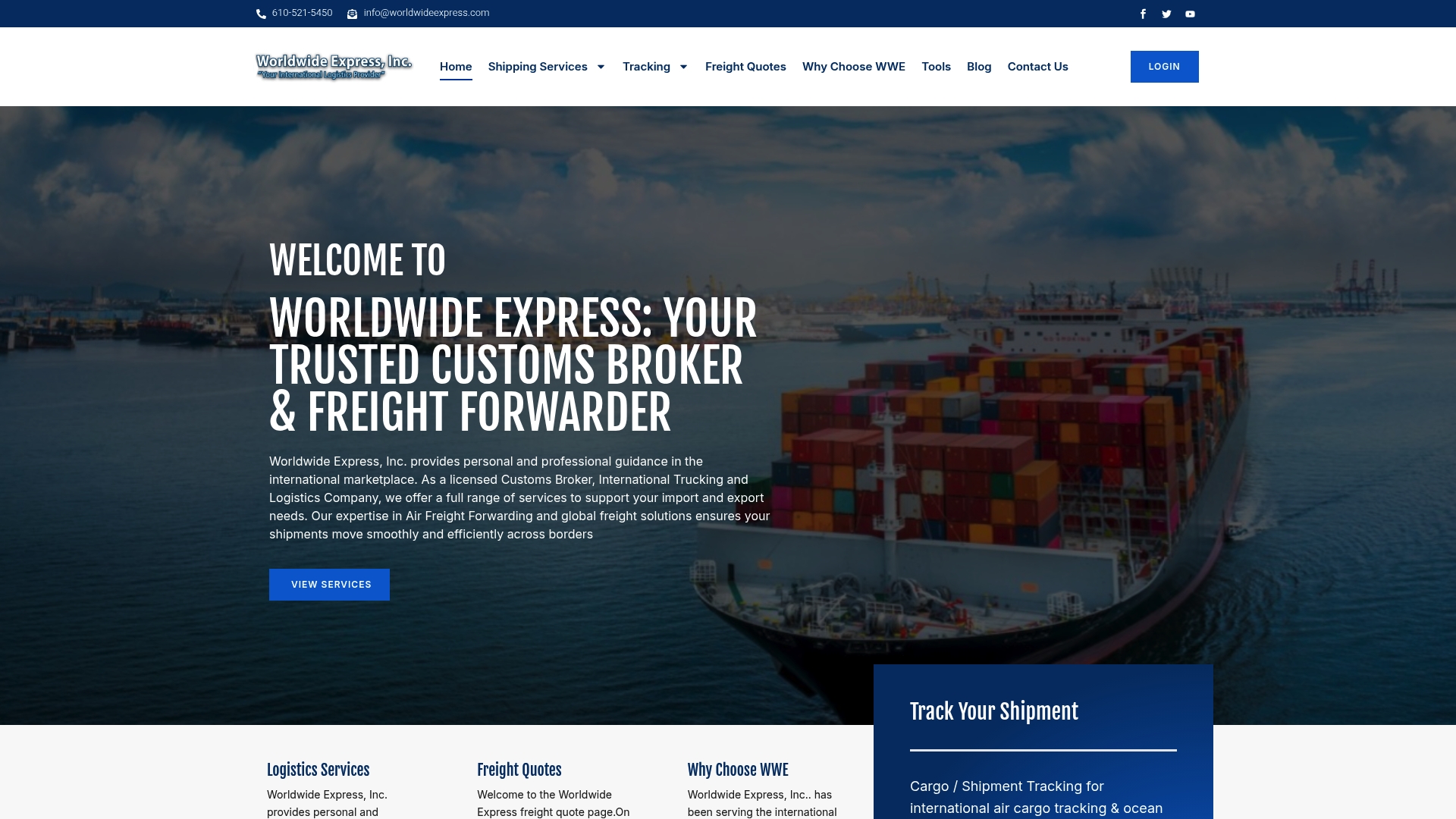
Experience the real benefits of transloading with Worldwide Express. Our dedicated team simplifies every part of your journey, from customs brokerage and documentation to warehousing and reliable global tracking. Take action today and discover how our tailored international solutions can turn your logistics pain points into smooth, cost-effective supply chain wins. Get started now by visiting Worldwide Express.
Frequently Asked Questions
What is the role of transloading in logistics?
Transloading plays a crucial role in logistics by allowing the transfer of cargo between different transportation modes, such as from ships to trucks or trains. This process enhances flexibility and efficiency in the supply chain, enabling businesses to optimize shipping routes and reduce costs. Consider evaluating your supply chain to identify areas where transloading could improve logistics operations.
How can transloading reduce transportation costs?
Transloading can significantly lower transportation costs by allowing businesses to choose the most economical routing and carrier options for different segments of a shipment’s journey. By consolidating smaller shipments and using varying transportation modes, businesses can save on per-mile expenses. Analyze your existing shipping strategies to determine potential cost savings through transloading.
What types of industries benefit most from transloading?
Various industries, including manufacturing, agriculture, and consumer goods, benefit from transloading to manage the efficient movement of goods. These businesses utilize transloading to adapt to logistical challenges and optimize supply chain operations. Assess your industry needs to explore specific transloading applications that may enhance your logistics framework.
What equipment is necessary for effective transloading?
Effective transloading requires specialized handling equipment such as cranes, forklifts, and conveyor systems, as well as spacious loading and unloading zones. Setting up a well-equipped transloading facility can facilitate efficient cargo transfer, minimizing damage during handling. Evaluate your facility infrastructure to ensure it meets the requirements for successful transloading operations.
How does the transloading process ensure cargo integrity?
The transloading process involves careful handling and planning to maintain cargo integrity during transfers. Trained logistics professionals follow specific protocols, including proper packaging and weight distribution, to minimize potential damage. Review your cargo handling procedures to enhance the safety and security of your shipments during the transloading process.
What is cross-docking and how does it relate to transloading?
Cross-docking involves unloading cargo from one transportation vehicle and immediately loading it onto another, often with minimal storage time. While both practices aim to optimize logistics, transloading specifically addresses the transfer between different transportation types. Consider incorporating cross-docking where applicable to further streamline your shipping operations.
Recommended
- Understanding Logistic Providers: Key Concepts Explained – Worldwide Express, Inc.
- Understanding Sustainability in Logistics: Key Insights – Worldwide Express, Inc.
- Understanding Trade Finance Solutions: A Clear Guide – Worldwide Express, Inc.
- Understanding What is Through Bill of Lading – Worldwide Express, Inc.

